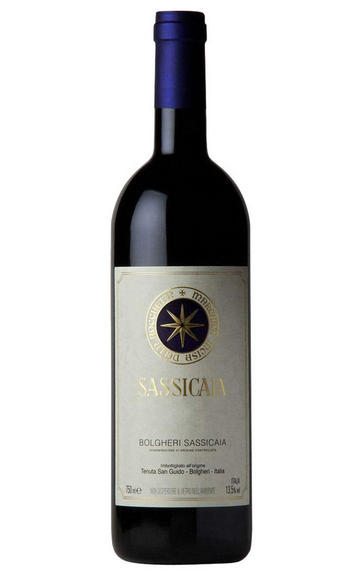
2013 Sassicaia, Tenuta San Guido, Bolgheri Sassicaia, Tuscany, Italy
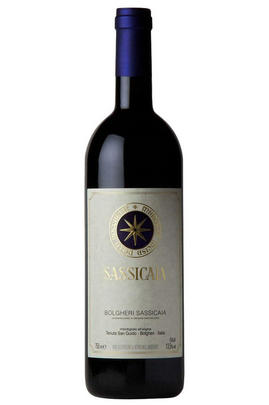
Critics reviews
Tasted from separate lots in barrel, the 2013 Sassicaia is shaping up to be a jewel of a wine. Rich, layered and expansive on the palate, the 2013 possesses remarkable depth, spherical texture and fine, silky tannins that wrap around the finish. A first sample, taken from a parcel in Mandrione shows remarkable perfume, while a second sample, from 40-year-old vines in Castiglioncello, is all about density and power. There is a lot to look forward to here, that much is obvious.
Tenuta San Guido fans will find much to admire in these new releases. The entry-level Le Difese and mid-tier Guidalberto are both strong (something that is not always the case), while the 2012 Sassicaia looks like it will drink well early relative to its historical track record. Sassicaia remains the most classic of the big Tuscan wines, with an emphasis on aromatic freshness and acidity that is the result of picking earlier than is common in most neighbouring properties. I was quite impressed with the wines I tasted on my most recent visit a few months ago.
Drink 2023 - 2043
Antonio Galloni, Vinous.com (October 2015)
Light cherry red in colour, with a beautiful vibrancy. On the nose, we have clean, bright redcurrant fruits. This is not the most intense year for Sassicaia, yet the palate comes through slowly but steadily, building in momentum until a smoky edge adds depth to the fruit. Gently, carefully the perfumed layers and fragrant richness really start to kick in through the mid palate.
There is a sense of the sheer cleverness of the balance. Lingering flavours of sage and blackberry that peep over your shoulder and prove themselves to be remarkably tenacious. Subtly beautiful. They use one-third new oak in all the recent vintages, and it is exceptionally well integrated for such a young wine.
Jane Anson, Decanter.com (October 2016)
I had reviewed this wine just a few months prior and my impression has remained pretty much the same. One difference I did notice at this more recent tasting of the 2013 Bolgheri Sassicaia is the bouquet. It has shifted to slightly more delicate and finessed aromas of pressed flower and blue violets. You do of course get that solid core of dark fruit and spice that characterizes this famous Tuscan blend. But that extra time in the bottle has awarded wiggle room for profound precision and focused detailing.
The wine's complexity emerges slowly with subtle notes of savory spice and tobacco. There is power and depth here, especially in terms of the mouthfeel. As the wine evolves in the glass, it begins to show ethereal tones of road paving, tar and licorice. This Sassicaia should go straight into the cellar.
Drink 2018 - 2040
Monica Larner, Wine Advocate (April 2017)
Mid-crimson with the strong balsam note on the nose that I noted when I tasted a couple of samples of this wine last month. Very much a restrained style – nothing like the full-on opulence of Ornellaia. I wonder whether there is quite a bit of younger-vine fruit in the blend? But it builds towards the most appetising and elegant finish. Pretty smart, but it seems just a little timorous. I don't think this will go down as one of Sassicaia's landmark vintages.
Drink 2020 - 2040
Jancis Robinson MW, JancisRobinson.com (November 2016)
Fabulous structure for a Sassicaia with powerful, polished, chewy tannins and ripe, subtle fruit. Aromas of blueberries, blackcurrants, rosemary and lavender. Full body, bright acidity and a savoury finish. Juicy and lively. Better to drink this beginning in 2020 but so impressive now.
James Suckling, JamesSuckling.com (November 2016)
The Sassicaia 2013 is just beautiful, and it takes a leap forward in quality. There is even greater precision and transparency with the aromas and flavours, there is a wonderful harmony and ease on the palate and there are even finer, and more seamless tannins on this wine. According to my co-host, Priscilla Incisa Della Rocchetta 2013 was a 'record vintage for Sassicaia'.
Carlo Paoli adds, 'Spring arrived early but without excess, summer started slowly and was only hot for 20 days and they started harvest mid-September for Cabernet Sauvignon. Everything was slow, calm and beautiful.' The 2013 is at the beginning of its drinking window and drinking beautifully now, but it still has a long time to go.
Drink 2022 - 2040
Susan Hulme MW, Decanter.com (November 2022)
About this WINE
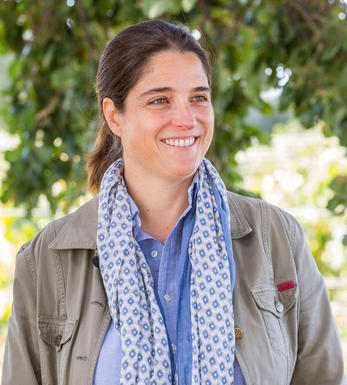
Tenuta San Guido
Tenuta San Guido's journey to becoming one of the world's most sought-after fine wines is largely owed to the vision and dedication of Mario Incisa della Rocchetta. The estate's origins trace back to his wife's family, who had owned land in Bolgheri since 1800. The name "Sassicaia," meaning "place of many stones," reflects the gravelly soil reminiscent of the Médoc region in France.
Mario Incisa della Rocchetta planted Cabernet Sauvignon and Merlot vines on this land and enlisted the expertise of Piero Antinori's winemaker, Giacomo Tachis. Tachis played a pivotal role in shaping Tenuta San Guido's winemaking philosophy and techniques.
In 1968, Tenuta San Guido released its first vintage, which garnered universal acclaim. Over time, it has become recognised as one of the world's finest Cabernet Sauvignon wines. Notably, Tenuta San Guido made history by being the first single wine to be granted its own Denominazione di Origine Controllata (DOC) status.
The wines of Tenuta San Guido are celebrated for their intense notes of cassis, coupled with a cedary elegance, and are renowned for their extraordinary power and length. This combination of factors has solidified Tenuta San Guido's position as a pinnacle of quality and prestige in the world of fine wine.
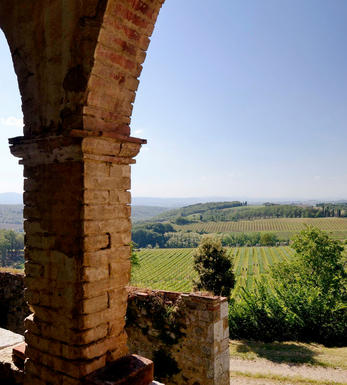
Bolgheri
Bolgheri is a new DOC in the coastal Maremma region which first rose to prominence during the 1970s with the emergence of the so-called Super Tuscan wines like Ornellaia and Sassicaia. These new ventures had rocked the DOC establishment by using high proportions of Cabernet Sauvignon, opting out of the DOC system and relabeling their wines as simply Vino da Tavola (table wine).
Having won universal acclaim and exchanging hands for unprecedented prices (higher even than Tuscany's finest examples), the authorities relented and awarded Bolgheri its own DOC. The actions of the Super Tuscans inspired a generation in Italy, even if some of the wines here have lost a little of their lustre since.
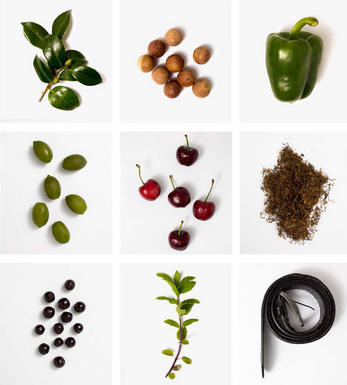
Cabernet Sauvignon Blend
Cabernet Sauvignon lends itself particularly well in blends with Merlot. This is actually the archetypal Bordeaux blend, though in different proportions in the sub-regions and sometimes topped up with Cabernet Franc, Malbec, and Petit Verdot.
In the Médoc and Graves the percentage of Cabernet Sauvignon in the blend can range from 95% (Mouton-Rothschild) to as low as 40%. It is particularly suited to the dry, warm, free- draining, gravel-rich soils and is responsible for the redolent cassis characteristics as well as the depth of colour, tannic structure and pronounced acidity of Médoc wines. However 100% Cabernet Sauvignon wines can be slightly hollow-tasting in the middle palate and Merlot with its generous, fleshy fruit flavours acts as a perfect foil by filling in this cavity.
In St-Emilion and Pomerol, the blends are Merlot dominated as Cabernet Sauvignon can struggle to ripen there - when it is included, it adds structure and body to the wine. Sassicaia is the most famous Bordeaux blend in Italy and has spawned many imitations, whereby the blend is now firmly established in the New World and particularly in California and Australia.


Buying options
Add to wishlist
Description
The Sassicaia 2013 is just beautiful, and it takes a leap forward in quality. There is even greater precision and transparency with the aromas and flavours, there is a wonderful harmony and ease on the palate and there are even finer, and more seamless tannins on this wine. According to my co-host, Priscilla Incisa Della Rocchetta 2013 was a 'record vintage for Sassicaia'.
Carlo Paoli adds, 'Spring arrived early but without excess, summer started slowly and was only hot for 20 days and they started harvest mid-September for Cabernet Sauvignon. Everything was slow, calm and beautiful.' The 2013 is at the beginning of its drinking window and drinking beautifully now, but it still has a long time to go.
Drink 2022 - 2040
Susan Hulme MW, Decanter.com (November 2022)
wine at a glance
Delivery and quality guarantee